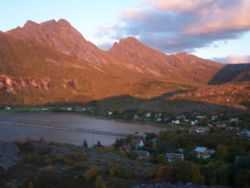Steigen
| Steigen kommune | |||
|---|---|---|---|
| Municipality | |||
|
View of the village of Nordskot | |||
| |||
 Steigen within Nordland | |||
| Coordinates: 67°47′54″N 15°10′19″E / 67.79833°N 15.17194°ECoordinates: 67°47′54″N 15°10′19″E / 67.79833°N 15.17194°E | |||
| Country | Norway | ||
| County | Nordland | ||
| District | Salten | ||
| Administrative centre | Leinesfjord | ||
| Government | |||
| • Mayor (2007) | Asle Schrøder (Sp) | ||
| Area | |||
| • Total | 1,007.86 km2 (389.14 sq mi) | ||
| • Land | 962.87 km2 (371.77 sq mi) | ||
| • Water | 44.99 km2 (17.37 sq mi) | ||
| Area rank | 105 in Norway | ||
| Population (2012) | |||
| • Total | 2,609 | ||
| • Rank | 282 in Norway | ||
| • Density | 2.7/km2 (7/sq mi) | ||
| • Change (10 years) | -9.7 % | ||
| Demonym | Steigværing[1] | ||
| Time zone | CET (UTC+1) | ||
| • Summer (DST) | CEST (UTC+2) | ||
| ISO 3166 code | NO-1848 | ||
| Official language form | Bokmål | ||
| Website |
www | ||
|
| |||
Steigen is a municipality in Nordland county, Norway. It is part of the traditional district of Salten. The administrative centre of the municipality is the village of Leinesfjord. Other villages include Bogen, Leines, Nordfold, Nordskot, and Sørskot. Engeløy Airport, Grådussan is located in the northern part of the municipality. Måløy–Skarholmen Lighthouse is located in the Vestfjorden in the western part of the municipality.
General information

The municipality of Steigen was established on 1 January 1838 (see formannskapsdistrikt). The southern part of Steigen was separated on 1 September 1900 to form the new municipality of Ledingen. This left 2,216 residents in Steigen. On 1 January 1964 a major municipal merger took place. The municipality of Steigen was merged with all of Leiranger, most of Nordfold (except the Mørsvikbotn area), the small Brennsund area of Kjerringøy, and the part of Hamarøy that was south of the Sagfjorden and around the lake Storvatnet. The new municipality was also named Steigen. Prior to the merger, the population of Steigen was 1,843, and after the merger, the new municipality had 4,545 residents.[2][3]
Name
The municipality (originally the parish) is named after the old Steigen farm (Old Norse: Steig), since the first church was built there (Steigen Church). The name is derived from the verb stíga which means "mount" or "rise" and it is referring to the high and steep mountain Steigtinden (tinden means "the peak") behind the farm.[4]
Coat-of-arms
The coat-of-arms is from modern times; they were granted on 12 October 1988. The arms show three black-colored axe heads from the Viking Age on a gold background.[5]
Churches
The Church of Norway has three parishes (sokn) within the municipality of Steigen. It is part of the Salten deanery in the Diocese of Sør-Hålogaland.
| Parish (Sokn) | Church Name | Location of the Church | Year Built |
|---|---|---|---|
| Leiranger | Leiranger Church | Leines | 1911 |
| Leinesfjord Chapel | Leinesfjorden | 1912 | |
| Sørskot Chapel | Sørskot | 1953 | |
| Nordfold | Nordfold Church | Nordfold | 1976 |
| Steigen | Steigen Church | Steigen | 1250 |
| Bogen Chapel | Bogen | 1926 |
Geography

The municipality is located along the coast of the Vestfjorden, about 100 kilometres (62 mi) north of Bodø, well inside the Arctic Circle. The road to Steigen departs from European route E06 and makes use of the 8 kilometres (5.0 mi) long Steigentunnelen (see World's longest tunnels). Steigen borders Hamarøy municipality in the north and Sørfold municipality to the south. The Vestfjorden and Lofoten are located west of Steigen. The Sagfjorden lies on the north and the Folda fjord in the south.
The municipality is mainly located on a peninsula dissected by many fjords. Steigen also includes several islands. The largest island is Engeløya, where there are ancient burial mounds (such as Sigarshaugen) and the world's most northerly naturally occurring Hazel forest in Prestegårdsskogen Nature Reserve. The largest glacier is Helldalsisen encircling a 1,361 metres (4,465 ft) mountain. Engeløya is connected to the mainland by the Engeløy Bridges.

Steigen has fertile lowlands in between the mountains and the sea. There are several archeological sites showing settlements from the Bronze age, Iron age, and Viking Age. Lakes in the region include Forsanvatnet, Hopvatnet, Makkvatnet, and Straumfjordvatnet.
Climate
The monthly 24-hr averages range from −1 °C (30 °F) in January and February to 13 °C (55 °F) in July and August, with precipitation ranging from 49 millimetres (1.9 in) in May to 146 millimetres (5.7 in) in October; annual average is 970 millimetres (38.2 in) and mean annual temperature is 5.1 °C (41 °F).[6]
References
- ↑ "Personnemningar til stadnamn i Noreg" (in Norwegian). Språkrådet.
- ↑ Jukvam, Dag (1999). "Historisk oversikt over endringer i kommune- og fylkesinndelingen" (in Norwegian). Statistisk sentralbyrå.
- ↑ Statistisk sentralbyrå (2001). "1848 Steigen. Population 1 January and population changes during the year. 1951-" (in Norwegian).
- ↑ Rygh, Oluf (1905). Norske gaardnavne: Nordlands amt (in Norwegian) (16 ed.). Kristiania, Norge: W. C. Fabritius & sønners bogtrikkeri. p. 249.
- ↑ "Kommunevåpen" (in Norwegian). Steigen Kommune. Retrieved 2008-11-29.
- ↑ "1961-90 base period for Grøtøy, Steigen" (in Norwegian). Norges meteorologiske institutt.
External links
| Wikimedia Commons has media related to Steigen. |
 Nordland travel guide from Wikivoyage
Nordland travel guide from Wikivoyage- Municipal fact sheet from Statistics Norway
- Steigen Municipality (Norwegian)
- Treveven:Hassel (Norwegian)
- Iron age in Steigen
- Steigen settled for thousands of years
- "Fant 6.300 år gammel nordlending i hemmelig grotte" [Found 6300 year old body of a person from North Norway]. NRK (in Norwegian). 2013-09-17.


